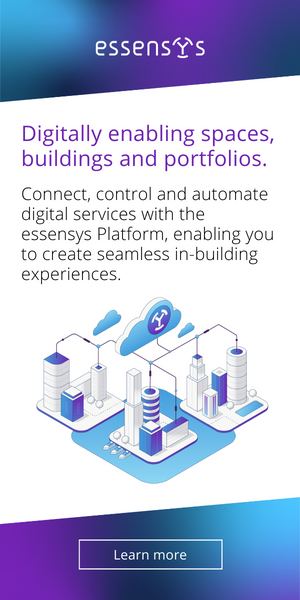What Are You Doing With All That Space?
Dennis Balgheim, Head of Partnerships, Microshare

If we’ve learned anything recently, it is to expect the unexpected. The unexpected can be a scary thing in commercial real estate, both for the owner and the occupier. Preparing for the unexpected is the only thing you can do during uncertain times.
Typically, decision makers use their best judgment based on experience, historic trends and trial and error. While that method has worked reasonably well in the past, the seismic shift we are seeing in the business world today requires a new way of thinking. Data now exists to take away almost all the risk and uncertainty from these decisions.
Asset owners: Wouldn’t it be great to know whether a tenant occupying 4 million square feet (371,600 meters) from you is likely to renew their lease, before you hear it from them?
Tenants: Don’t you want to know if you are actually using all three floors of space you are paying for?
Occupancy sensors provide data that was not previously available and help answer these questions. Such data is one of the most powerful tools available to commercial real estate professionals when forecasting future demand or configuration within a portfolio. Lease renewal, of course, is directly relevant. Real-time occupancy data shows a far more granular view than building access data on how and when a space is being used. It achieves this by anonymously measuring the activity of people in the building or space at any time of the day. By using data from an occupancy sensor, high and low traffic times can be tracked and adjustments can be made to services – from heating and lighting to catering, cleaning and security. The cost and labor savings are significant.
Asset owners: Be proactive and prepared
A perfect use case comes from a Microshare client, the Kilroy Realty Corporation, a major real estate investment trust their facilities team placed occupancy and people-counting sensors in the foyer and elevator lobby of a 22-story building to monitor activity on each floor. With this data, they discovered which areas of their building had high activity and which were largely vacant. After just three months of compiling data, they found that thousands of square feet were sparsely utilized and therefore more vulnerable to vacancy. Kilroy is now better prepared to enter lease negotiations and can plan for alternative ways to design their spaces in order to make the most of their properties.
This granular look at tenant behavior offers several benefits to asset owners. Owners can track activity in a variety of spaces in their buildings, such as gyms, common areas and even break rooms. If that common area is barely occupied, then replacing it with a lower-cost amenity could be an option. If the gym is overcrowded, perhaps it’s time to build an extension. This kind of usage data also has implications for cleaning and security routines as well as heating and cooling. Armed with this knowledge, owners can better serve their tenants in a proactive manner and get a better idea of tenant satisfaction, which gives an indication of lease renewal plans.
Tenants and occupiers: Don’t drown yourself in space
For major global real estate owners and tenants, the cost implications can be huge. In one example, the global technology services and consulting giant Capgemini is currently implementing over 200,000 LoRaWAN (long-range, low-power) occupancy sensors of precisely the kind Microshare supplies across its 500+ buildings portfolio. These sensors, deployed in over 60 countries in about 16 million square feet of space (1.5 million square meters) has resulted in immense real estate savings.
Prior to implementing this technology, Capgemini’s real estate team would travel around the world and talk to the site managers at each office to determine space needs before an office lease renegotiation would come up. Typically, the site managers would report that they were using their space to capacity and on occasion request that additional space be added onto the lease. Being that there was no way to track the space usage, the real estate team had little opportunity to challenge. By embracing the Google adage that “data beats opinion” and since leveraging the power of occupancy data, the real estate team has begun cutting down 40–50% of space that isn’t being utilized and saving over $100 million in leasing costs.
In addition to the financial implications of empty spaces and vacant desks, there is a sustainability aspect to this. Commercial real estate, construction and related industries are major contributor to carbon emissions across the world, with the UN and others estimating the figure at about 38%. It has also been estimated that an empty desk is equivalent to driving over 3,800 miles in a diesel car. As the legislative focus on how businesses impact the world grows, governments, investors, customers and employees are all going to demand more data. IoT sensing and retrofit data solutions, such as those offered by Microshare, provide a tried and tested way for organizations to obtain meaningful information from their real estate portfolios to help with reporting and moving the needle on ESG initiatives.
If you want to determine the true value of all the space you own, lease or manage, it’s time to invest in the technology that will deliver the data you need. Microshare’s EverSmart Space and related products do just that.
This Week’s Sponsor
Microshare leverages the power of Internet of Things (IoT) data to solve real-word problems. Our Sensing-as-a-Service model takes the complexity out of IoT, enabling the creation of Digital Twins of our global clients’ physical assets. This unlocks previously hidden data insights that secure people and places, produce cost savings and sustainability metrics. Visit Microshare.io to learn more.
Read Next
 5/15/2025
5/15/2025
Tech, Talent and Transformation: 2025 Digie Finalists Announced For 27 years, Realcomm has presented the Digie Awards to acknowledge companies, real estate projects, technologies, and individuals that have advanced the commercial real estate industry through the strategic use of technology, automation, and innovation.
 5/15/2025
5/15/2025
Empowering Space Management with Data-Driven Visualization For effective CRE space management, it’s critical to centralize lease data, maximize rental square footage (RSF), improve energy efficiency and reconfigure spaces to meet changing needs.
 5/8/2025
5/8/2025
The AI-Powered Workplace Evolution: Redefining the Business Landscape In today's rapidly evolving business environment, the fusion of Artificial Intelligence (AI) and Workplace Management is revolutionizing the way organizations approach workspace optimization and operational efficiency.
 3/27/2025
3/27/2025
The Convergence of Edge Computing, Cloud, and AI in Building Automation and Smart Buildings In the built environment, we have seen the convergence of Operational Technology (OT) and Information Technology (IT), later expanding to include Workplace Technologies (WP).




%20(1)%20(1)%20(1).png)








